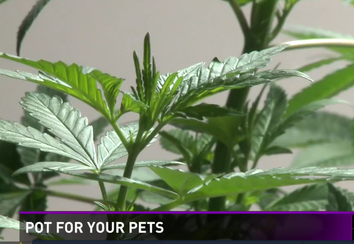 It's become the latest trend - with more and more dog owners turning to Cannabis to help treat everything from their animal's pain to anxiety. Littleton resident Leslie Padzick is one of them. For the past few years, her aging Schipperke, Luca -now 12- has suffered from anxiety. This spring, Luca's vet found a large tumor growing in his body. Padzick contemplated an expensive surgery but worried Luca wouldn't make it through such an invasive procedure at his age. “I really wanted to find another option to help him,” said Padzick. She hopped online and began researching alternatives to help with Luca’s discomfort. She found a growing trend inside of medical marijuana shops: pot marketed towards pets. They're In the form of Cannabidiol or CBD oil- which is derived from both Cannabis and Hemp, but don’t include THC, the ingredient that produces the high. “When I get woken up at midnight by Luca, and for two hours I just try and calm him down, it’s hard. I feel like I have a sick kid and I just want to help him,” said Padzick, “And why go through all of that when we have another option? Pot is in our news every day so obviously more and more research is going into it—so why not try it?” It’s a growing mindset among pet owners. “I wish a veterinarian could prescribe it for my dog, I wish I knew just how much to give him,” said Padzick. “It’s not like I’m giving my dog a joint, that’s not what I’m doing. It’s not a big party- it’s another medicinal option. And I want to know more.” Veterinarian Dr. Kevin Fitzgerald says there is still much research to be done on the impacts and side-effects of pot used on pets before he can get behind the idea. He’s not alone. The ASPCA and PETA have not endorsed Cannabis for animals due to a lack of research and veterinarians, like Fitzgerald cannot prescribe medical marijuana for animals. “Can this stuff hurt them? I don’t know. How much should you give? I don’t know. Does it work? I don’t know” said Dr. Fitzgerald, “If it works, I’ll be the first one to get behind it, but until more trials are done and we know, I am not willing to gamble with the health of our patients.” Meanwhile, Padzick is willing to try it out. She has heard several success stories on CBD oil use on dogs. “I have a friend who has been using CBD oil on her aging dog and she says it is working, he is sleeping better.” As for Luca, Padzick just wants to do whatever she can to help him feel better. “I feel like if it's not getting him high, there’s got to be other benefits, so let’s give it a try at least. At this point, don't have very many options.” Padzick’s goal now is to figure out how to get it. Some people who already have medical marijuana cards are able to buy pet-marketed products at medical marijuana shops. Some pet-marketed products are sold at recreational pot shops, but products there that contain CBD oil also have THC in them. According to the Colorado Cannabis Chamber of Commerce, pet owners are able to buy pet-products with CBD’s derived from Hemp online. There are also special boutique stores that sell Hemp products for pets as well. VIDEO LINK for 9 News Segment Source: KUSA 9 News / Christine Noel A Peaceful Farewell provides compassionate at home pet euthanasia to fellow pet owners in Chandler, Gilbert, Mesa, Tempe, Ahwatukee, Scottsdale, and most of the Greater Phoenix Metropolitan Area.
1 Comment
 When searching for a new canine companion, it’s easy to fall for the energy and adorableness of a puppy. But remember, youth comes with challenges—chewing, housebreaking and obedience training.If you’re looking for a well-mannered mutt that still has a lot of love to give, consider taking home an older dog. In honor of Adopt a Senior Pet Month, which encourages the adoption of dogs age 7 or older each November, we’re sharing 10 reasons senior pets make wonderful additions to the family. Tracey Stewart, wife of comedian Jon Stewart and well-known animal lover, shares 10 tips from her new book Do Unto Animals. She says many senior pets were raised in loving homes and have since lost their guardians due to divorce, illness, or death—none of which changed the love between them and their guardians. Seniors are simply looking to share their loving nature with a new family. 1. They come with few surprises. There’s no need to wonder how big they will grow, how often they will need to be groomed, or what their personality will be like. What you see is what you get! 2. Bye-bye, potty-training manuals! Seniors are likely to have already been house-trained—or if they haven’t been, they are physically and mentally ready to pick it up in no time. 3. It’s nice to say things just once. Seniors have been around humans long enough to understand our language. They often know what we are asking or can quickly learn to do as we ask. You can teach an old dog new tricks, and fast! 4. They fit right in. A senior dog or cat has been around the block a few times and has come into contact with many other dogs, cats, and people. Seniors usually know what it takes to effortlessly fit in with a family and can do it with ease. 5. You can relax! Unlike a puppy or kitten being introduced to a home, a senior animal usually isn’t constantly getting into trouble. You don’t have to puppy-proof or kitten-proof your house for months on end. 6. They enjoy brisk walks and don’t ask for much. Older dogs do not require being taken on three runs daily, and they will tire of playing fetch after a short while! Although they do need exercise, seniors are often fine with a nice walk in the morning, aside from potty breaks. 7. Your favorite new shoes will be safe from doggy damage. With their teething years behind them, destructive chewing is usually a thing of the past. 8. Age is just a number. Age doesn’t always mean health problems and expensive medical bills. Young animals can develop health issues as well, and medical bills are usually par for the course throughout an animal’s life. Each animal is an individual and deserves to be viewed without judgment. 9. They give your heartstrings an extra tug. There is something incredibly powerful about providing sanctuary, love, care, snuggles, and ultimately peace to a senior pet in his or her final years. 10. Short but sweet time spent together. Kids go off to college, people retire, and situations change. Sometimes we might have a more limited period of time to devote to the care of a special animal. You can still benefit from the companionship of a super senior. Source: Parade.com / Heather Thompson A Peaceful Farewell provides compassionate at home pet euthanasia to fellow pet owners in Chandler, Gilbert, Mesa, Tempe, Ahwatukee, Scottsdale, and most of the Greater Phoenix Metropolitan Area.
 These days, we generally break animals down into three groups: pets, farm animals, and wild animals. But not too long ago, there was another category that would have instantly come to mind as well: working animals. Centuries and even just decades ago, it was the norm for everyone to have several animals to help with crucial tasks such as transportation or farm work. From horses pulling carriages to dogs herding sheep, these animals may have been loved as pets, but they had definite jobs they had to do, first and foremost. Today, even though many don’t realize it, animals are still called in to help with specialized tasks that they can do much better than humans. Here are a few of the most interesting and unusual jobs they do. 1. Military Jobs: The U.S. Navy actually has a program called the U.S. Navy Marine Mammal Program, in which bottlenose dolphins and California sea lions are trained to protect ships and harbors, recover equipment, and detect mines. But sea animals aren’t the only ones who can sniff out mines and other threats. African giant pouched rats are also used to locate mines and other explosives in some places in the world, and of course, dogs are also commonly used for the same purpose. 2. Energy Production: With current trends leading energy companies to look for more and more efficient and environmentally friendly ways of producing electricity, the animal world may have already produced the perfect renewable energy source for some energy needs: electric eels. Scientists have actually learned how to harness the eel’s natural electricity, which comes in bursts of 600-650 volts at a time, and are researching how to use this understanding of their electricity-producing cells to power things such as implanted medical devices. 3. Massage Therapy: As unappealing as it may sound to most people, spas around the world are beginning to embrace snakes as massage therapists. Placing non-venomous snakes, such as milk snakes or corn snakes, into contact with bare skin and allowing them to slither their way around is said to produce a relaxing massage for muscles. 4. Transportation: Even though horses have been replaced by cars and bicycles in most places, there are still corners of the world where people rely on animals for their transportation. For example, riding on a camel is still a common way to get around in arid desert regions, while snowy climes are still home to sled dogs and even reindeer who pull sleighs. 5. Heavy Lifting: In places where trucks and construction equipment just aren’t available, animals are still called into service to take care of the heavy lifting. Donkeys can carry loads on long journeys, while elephants are used for lifting and moving extremely heavy materials short distances. 6. Detective Work: Last but not least, dogs are used as detectives on a regular basis all around the world. Renowned for their olfactory abilities, they are able to sniff out drugs, explosives, and even criminals themselves easily, helping police to do their own jobs more effectively. So while horse-drawn carriages and plows pulled by oxen may be things of the past, animals still pitch in and help humans in their work, all over the world. Source: pettage.com A Peaceful Farewell provides compassionate at home pet euthanasia to fellow pet owners in Chandler, Gilbert, Mesa, Tempe, Ahwatukee, Scottsdale, and most of the Greater Phoenix Metropolitan Area.
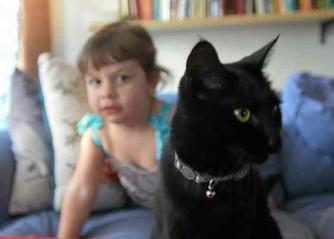 It was 6:30 p.m., and Sheba was nowhere to be seen. The indoor-outdoor cat was known for being punctual for her dinner. Sheba's caretaker, Riley McDermid, wasn't immediately concerned, but when the food remained untouched the next day, it seemed that Sheba was missing. McDermid checked shelters for the microchipped cat and asked neighbors through NextDoor -- a residential social media app that connects neighbors to each other -- about whether they had seen Sheba. McDermid searched for the friendly, black cat in the neighborhood, but to no avail. A week later, after talking with a neighbor, it became apparent that maybe -- just maybe --the cat had taken a 1,600 mile trip. To Omaha, Neb. Suspicions McDermid's neighbor had recently passed away and his adult children had come into town from Omaha to move out items -- including his three cats --from his apartment. On Sept. 19, the day the family had packed their U-Haul for Nebraska, the three cats had gotten out and the neighbor's son and daughter searched for the felines, including a black cat named Lucy. Another neighbor told McDermid that they had seen the siblings leave town with a cat carrier. "Sheba's not skittish and not wild," McDermid said of her cat. "She probably went up to them and they weren't familiar (with their dad's cats) and they had thought it was just one of the cats that had gone back (to his home). ... I briefly hoped that they had the cat." Sheba was adopted by the family in February after being rescued from a coal factory in Crockett. The cat played well with McDermid's 2-year-old daughter, Frankie, and got along with their cattle dog, so McDermid felt she had to try and find Sheba. Finding out the contact info for the son and daughter, McDermid sent Facebook messages and text messages, made phone calls to the two, but did not hear back from them. Getting no reply, the question remained: What were the chances that Sheba was in Omaha? Investigation Tracking down a cat in another state was out of McDermid's experience as a reporter, but having a strong clue that the cat was in Omaha spurred McDermid to try another avenue: A private investigator. "I was sure we'd never see her again," McDermid said. "...This was a last ditch effort and if she was anywhere, she'd be with these people." Looking up private investigators in Omaha, McDermid called around to see who would take a case like this. On her fourth try, she found Mona Kay, who was willing to give it a shot. Kay's practice, Mona K. Investigations, rarely deals with missing pet cases, but she wanted to try and find Sheba for McDermid's family. "Deep down in my gut I really thought I would (find Sheba)," Kay said. "I know my determination and I don't give up easily. I really thought if these people still had the cat, I would find it." Researching the names, Kay came up with four addresses in the Omaha area. At the first house, Kay found Brittany Hulett and, armed with a photo of Sheba, asked if Hulett had seen the cat. "I introduced myself and told her I was a private investigator and I showed her the picture and said, 'Does this cat look familiar? Have you seen this cat?'" Kay recalled. "... I said, 'I'm here to find this kitty, it belongs to a nice family that loves it and misses it and wants to get their kitty back." Hulett told Kay that Sheba was inside her house. Kay saw Sheba -- wearing the exact same collar from McDermid's photos that she had sent along -- and knew she had found the right cat. "They brought the cat out to me," Kay said. "It was much easier than I ever anticipated, which is shocking. I locate people all the time, some take weeks or months and then finding a cat (from) across the country takes three minutes." Hulett said that it was Kay's surprise visit to her home that made her realize she had brought the wrong cat to Omaha. "That's what convinced me that maybe it wasn't (my father's cat)," Hulett said on the phone. "Because who would really go to that extreme? That's why I was like, 'Just take it.' It had to have been true." "What were the odds?" Hulett later added about the mix-up. "Two little black cats, green eyes, same neighborhood." When asked why she took the case, Kay said she loved animals and if this happened to one of her pets -- the private investigator said she has three cats, fish and frogs -- she, too, would have hired a private investigator. "I would be so upset if someone took one of my animals," Kay said. "I would do the same exact thing. I know most people wouldn't, but... I wanted to at least give (the case) a try." "I don't think a lot of private investigators would take the case," Kay later added. "They would have said, 'Oh gosh, I'm not gonna go find a cat. I can't go find a cat, they all look the same.' I can't imagine anyone going to go look for a cat and so I thought she's lucky she found me ... I think a lot of people would have thought it's a wild goose chase." Sheba had finally been found, after having gone missing for 18 days. Reunion Bringing the cat home with her, Kay called McDermid to give her the good news -- only an hour after the two had first spoken on the phone about Sheba. "I called her and said, 'Guess who's here at my house' and she said, 'You have my cat!'" Kay said. "I just started crying," McDermid said of that phone call from Kay. "I couldn't believe it." Saying she's not a "cat lady," McDermid said that her story got its share of opinions at work, drawing comparisons to "Homeward Bound" and "Milo and Otis." "Half of my colleagues in the newsroom thought it's a great story, the other half thought I was crazy," McDermid said of her co-workers. "Once I knew where she was, I had to go get her." "I'm not really a cat person," McDermid later added. "I'm not a big cat lady, I don't like cat memes, but Sheba's just so good with my daughter Frankie that I thought I need to figure out what happened." McDermid disputes Hulett's account of the situation as a "mix-up," and said the siblings ignored two weeks of messages offering a reward and money to ship the cat back. McDermid had also filed a police report at the time the cat went missing. Three days after Sheba was found, Kay shipped the cat home on a plane on Oct. 10 to San Francisco Airport. McDermid and her family picked up Sheba shortly after midnight, three weeks after her adventure first started. And now, every day at 6:30 p.m., Sheba is home for dinner with her family. Source: Times-Herald / Dianne de Guzman A Peaceful Farewell provides compassionate at home pet euthanasia to fellow pet owners in Chandler, Gilbert, Mesa, Tempe, Ahwatukee, Scottsdale, and most of the Greater Phoenix Metropolitan Area.
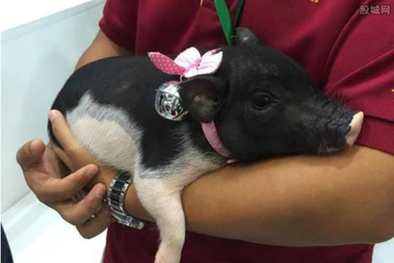 A Chinese research company is planning to sell its 'micro pig' as a pet after it successfully edited the DNA of the animal to stunt its growth. Beijing Genomics Institute (BGI) created the pig, which grows to weigh between 14 and 20 kilograms, by changing the DNA responsible for its growth. The company originally genetically modified the Bama pig breed for research but announced at a Bio Tech Leader summit in China recently their plans to sell it. But the reasons as to why researchers are excited about the micro pigs are quite different to people wanting a petite pet porker. Researcher Dr Hannah Brown from the University of Adelaide said gene editing techniques were fascinating. "It's almost like GPS-guided molecular scissors," she said. "What they do is they put those scissors into a cell and those scissors attract specifically to a place in the DNA. "They can make a cut and cut out a piece of DNA and exchange it for a different piece. "In this case this is actually what they did in pigs. "They took some pigs cells and they put in these molecular pair of scissors and they trimmed out a piece of the DNA that determines how big the pig grows," Dr Brown said. Dr Brown said it's understood the pigs were firstly created for medical research. "They were attempting to generate a smaller and faster-breeding pig so they could use them for genetic testing for the development of disease models. "The thing about pigs is that generally they are quite large and expensive to look after, so reducing the size of the animals means that it's less expensive to work with and easier to look after." What genetic editing could mean for human health In terms of research, Dr Brown said the pigs were of high interest. "Evidence like this, a generation of what looks like happy live pigs, is really exciting. "It means we are advancing what we know about these genetic-editing technologies and advancing towards a place where maybe we will be able to use them to cure diseases in humans." Dr Brown said successfully editing the pigs' growth wasn't far removed from curing a human disease. "Research-wise they aren't that far apart," she said. "Curing a genetic disease would require us to identify the message in the DNA that's faulty and replace it and that's basically what they did in these pigs. "They took the pig DNA and cut out the part of the message that we know regulates pig growth. "We now know that many of the genes or many of the parts of the DNA that regulate diseases like Huntington's and Cystic Fibrosis. "Potentially this offers us hope in terms of hoping to trim out those disease-causing bits of DNA in humans," Dr Brown said. Dr Brown said research coming out of China was already looking at modifying human DNA, in a contentious way. "Three or four months ago there was some similar technology that looked like it had been pushed out of China in terms of genetically modified human embryos. "This was really concerning because we hadn't seen a lot of this same technology being used in large animals, we had seen it be used with cells in the dish, we had seen it being used in rodents — but not in larger animals." Dr Brown said cloning work was occurring in Australia but not in this form. "In terms of generating cloned pigs and miniature pigs, that kind of research isn't going on, I'm not aware of it," she said. "In pigs we do clone for other reasons so there's research looking into pigs as models for diabetes, as the pig is very similar to the human in many mechanisms." A company spokesman said the animals were expected to live to 15 to 20 years old. However Dr Brown did say the micro pigs had only been through one reproductive cycle, so its life expectancy was yet to be proven. "We don't really know what their outcome is long term; we don't know if they'll live a happy full life based on the fact that we have modified their DNA," she said. "They may be completely normal, but the jury is still out on whether that's the case or not." Source: ABC Rural / Tyne McConnon A Peaceful Farewell provides compassionate at home pet euthanasia to fellow pet owners in Chandler, Gilbert, Mesa, Tempe, Ahwatukee, Scottsdale, and most of the Greater Phoenix Metropolitan Area.
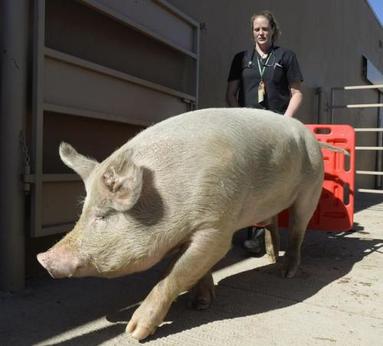 LONGMONT, Colo. — A 650-pound pig that fell off a trailer in Colorado is getting a new name -- "Lucky" -- and a new home at a sanctuary for abandoned pigs. The Daily Times-Call reports (http://bit.ly/1hsk5eM ) that Lucky rolled onto Interstate 25 on Sept. 30. He was probably destined for a slaughterhouse, but will instead be headed to a cozy home east of Denver. The Weld County Sheriff's Office couldn't find the 3-year-old pig's owner, so the boar was given to Hog Haven Farm owner and director Erin Brinkley-Burgardt. Brinkley-Burgardt says she primarily cares for pot-bellied pigs, which people buy as pets but often abandon as they grow larger. The veterinarian who treated Lucky says he appears to be a Yorkshire pig. Brinkley-Burgardt says Lucky can expect to live about 13 years in captivity. A Peaceful Farewell provides compassionate at home pet euthanasia to fellow pet owners in Chandler, Gilbert, Mesa, Tempe, Ahwatukee, Scottsdale, and most of the Greater Phoenix Metropolitan Area.
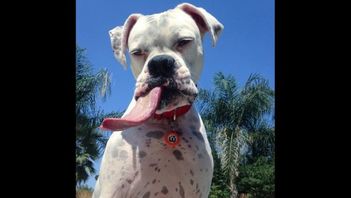 A deaf white boxer and her unusually long tongue are helping to raise awareness and bring positive attention to shelter animals and animals with disabilities, Fox 11 reported. Semi, who was adopted by Farrah Marx in 2012, is currently on her way to Instagram fame as Marx chronicles what it is like to train a deaf dog. “I did a little research on training deaf dogs, but for the most part it was her trust in me and our relationship that made everything work out smoothly,” Marx told Fox 11. “We use hand signals— we have one for ‘Good job’ so that she is always validated when she does something good, ‘no’ or ‘stop that,’ ‘sit,’ ‘stay,’ ‘lie down’ and ‘shake hands.’” Marx told the news station that one of the biggest challenges she faces is when Semi is acting stubbornly and won’t make eye contact. Semi is also featured on socks as part of a campaign to raise fund for shelter dogs. Marx is planning on having her tongue measured to see if she has the Guinness record for World’s Longest Dog Tongue. Marx told Fox 11 her experience with Semi has been incredible, and she is growing into a fully adaptive dog. Source: FoxNews.com A Peaceful Farewell provides compassionate at home pet euthanasia to fellow pet owners in Chandler, Gilbert, Mesa, Tempe, Ahwatukee, Scottsdale, and most of the Greater Phoenix Metropolitan Area.
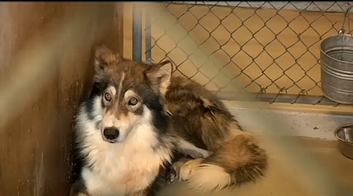
PIMA COUNTY - There are countless animal lovers in Tucson, so stories of mistreatment strike a nerve.
Dogs seized from a hot car one week ago have been returned to their owner. The animals were cleared to go home on Wednesday, but one dog rescue group is asking why the owner was allowed that option. "With what the dogs have already been through, it is very traumatic for any dog, no matter what condition they're living in, to be taken from that environment and put in a shelter with people they don't know, and then returned back to these conditions," said Leah Cox, with Charlotte’s Way Dog Rescue. Cox was hoping she'd get the chance to rescue and rehabilitate the pack. She said many were shy and unsocialized. They're already working with ten of the dog's yard mates, surrendered by the same owner just days before the hot car incident. "My biggest worry for these dogs is they're not going to have that chance," said Cox. "We’re very grateful for all the people that care about animal welfare in our county, we rely on them to keep our animals safe,” said Detective Robin Crehan with the Pima County Sheriff’s Department. "While people, many times, see their pets as children or family members and treat them as such, that is not an action that is required by law, being sufficient food water and shelter at the very least, and immediate attention to any medical issues that may arise." PCSD said it must enforce the laws as they are written. In Arizona, dogs are considered property. Even with charges pending, an owner may still be entitled to them, depending on the severity of the charges. Each case is looked at and evaluated individually. "The individual was found to be, upon investigation, in compliance with current licensing and other laws," said Det. Crehan. "The animals themselves were in good condition." Rescuers are working with the ten dogs surrendered by the man. The hope is that they can be adopted out in the coming weeks. Source: KVOA.com / Lauren Reimer
A Peaceful Farewell provides compassionate at home pet euthanasia to fellow pet owners in Chandler, Gilbert, Mesa, Tempe, Ahwatukee, Scottsdale, and most of the Greater Phoenix Metropolitan Area.
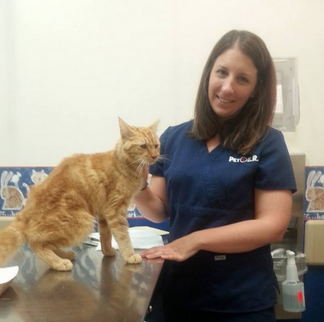 A cat stuck in a tree in Baltimore was rescued Monday by a good Samaritan, reportedly after weeks without food or water, an animal rescue organization said. The feline had climbed a tree near Loch Raven Boulevard and Woodbourne Avenue near Kensington Gate Apartments in New Northwood. The cat had been in the tree for nearly four weeks, A Baltimore resident said in an email to Animal Rescue, Inc., the group said. "I felt sick to my stomach when I read that e-mail," said Ashley Carlson, the organization's director of animal health and welfare. "I knew we had to do something." Animal Rescue posted about the cat in distress on its Facebook page, which the group said drew the help of a contractor who scaled the 80-foot tree and brought the animal down. The animal was taken to a veterinarian clinic in Towson, where he was given food and fluids before being released to go to Animal Rescue's headquarters in Pennsylvania. The group has dubbed the cat "Branch" and plans to take care of him until the owner is able to pick him up. Source: The Baltimore Sun / Colin Campbell A Peaceful Farewell provides compassionate at home pet euthanasia to fellow pet owners in Chandler, Gilbert, Mesa, Tempe, Ahwatukee, Scottsdale, and most of the Greater Phoenix Metropolitan Area.
Don’t you wish you knew what your dog was thinking? It would make all of our lives so much easier. Several laboratories are working on questions related to how dogs think about the “physical and social world.” The Yale University Canine Cognition Center is one. It is devoted to learning how dogs “perceive their environment, solve problems, and make decisions.” Their findings will “teach us how the dog mind works, which can help us to better develop programs to improve how we train and work with our canine friends.” The researchers use several different types of studies to investigate how dogs think: Looking Measures — In “looking” games, dogs are asked to sit while being shown a small stage and a series of events. Sometimes one of these events will involve something that’s unexpected—an event that appears to violate physical or social principles. When dogs detect the violation, they will look longer at the display as if they are “surprised.” In this way, we can see what dogs know simply by measuring how long they look at certain events. Social Cues — By using simple pointing and looking gestures, we can see if dogs understand our intentions and goals. In a typical game, dogs see one of our staff cueing the location of hidden food treats. We then give them a chance to search for the food and see what types of cues they naturally use. Choice Measures — Dogs’ decisions reflect how they process the world. In a typical choice game, dogs get to choose between two different boxes that have different numbers of food, balls, or other toys. From their choices, we can tell whether they can distinguish between different kinds of objects and learn more about their understanding of numbers. Touchscreen Testing — In this type of study, we teach dogs to make choices using their nose on a touchscreen. Once they become touchscreen experts, we can then show them new and interesting events to see how these events affect their decisions. Sounds like a lot of fun for the dogs, owners (yes, owners get to stay with their dogs), and researchers! Yale’s Canine Cognition Center is looking for dogs of all ages, sizes, and breeds to participate in their work. Dogs must be healthy (free from any contagious illness), have no history of aggression, be current on their rabies, distemper/parvo, and bordetella vaccines, and have a negative stool sample (including Giardia) within the past six months. Puppies must be over 16 weeks of age, have already received at least their third set of vaccinations, and have a clean stool sample. If you live in the New Haven, CT area and want to see whether your dog is “Ready for the Ivy League,” take a look at the Canine Cognition Center’s webpage. For a peek into what a session in the lab might look like, watch this report that aired on the Today Show awhile back. Source: Pet MD / Dr. Jennifer Coates A Peaceful Farewell provides compassionate at home pet euthanasia to fellow pet owners in Chandler, Gilbert, Mesa, Tempe, Ahwatukee, Scottsdale, and most of the Greater Phoenix Metropolitan Area.
|
The PAW Blog...
For the LOVE of Pets The goal of this blog is to help educate pet owners by sharing pet health facts and pet news articles...and ... sometimes put a smile on your face with a cute or funny pet story! Categories
All
Archives
July 2024
Search for any topic...
|


 RSS Feed
RSS Feed

